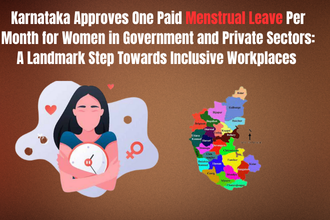Introduction
In a historic move aimed at promoting gender-sensitive labour reforms, the Karnataka Cabinet has approved the Menstrual Leave Policy 2025, allowing women employees in both government and private sectors to avail one paid leave per month as menstrual leave. The announcement was made on October 9, 2025, by Chief Minister Siddaramaiah, marking Karnataka as one of the few Indian states to officially recognize menstrual health as a legitimate workplace concern.
The policy provides up to 12 paid menstrual leaves annually, reflecting the State’s commitment to creating humane and inclusive work environments that acknowledge the physiological and emotional realities faced by women during menstruation.
Background: From Recommendation to Reform
The Menstrual Leave Policy 2025 stems from the recommendations of an 18-member expert committee constituted in 2024, chaired by Professor Sapna S, Associate Dean and Head of the School of Law at Christ (Deemed to be) University. The committee included diverse stakeholders—industry representatives, trade union members, doctors, gynaecologists, and professors from the Institute of Social and Economic Change (ISEC)—who studied the impact of menstrual discomfort on workplace participation and productivity.
After extensive consultations, the committee submitted a comprehensive report advocating for a structured menstrual leave system. Acting on these recommendations, the State Cabinet approved the policy, positioning Karnataka at the forefront of gender-responsive labour governance in India.
Key Features of the Menstrual Leave Policy 2025
1. One Paid Menstrual Leave per Month
Women employees across all sectors—government, private, industrial, and corporate—can avail one paid menstrual leave every month, totaling up to 12 days annually.
2. Universal Application
The policy extends to a wide range of workplaces, including government offices, IT firms, multinational corporations, garment factories, and private sector organisations. This inclusivity ensures that menstrual health considerations reach even women working in labour-intensive or informal sectors.
3. Recognition of Menstrual Health as a Workplace Issue
By framing menstrual leave as a matter of public health and gender equity, Karnataka’s initiative goes beyond tokenism. It acknowledges menstruation as a natural biological process that deserves accommodation in workplace policies.
4. No Deduction in Pay or Benefits
The menstrual leave will be fully paid and will not affect other entitlements such as casual leave, earned leave, or medical leave, making it a standalone benefit exclusively for menstrual health.
Chief Minister Siddaramaiah’s Statement
Announcing the decision on social media platform X (formerly Twitter), Chief Minister Siddaramaiah stated:
“Through the Menstrual Leave Policy 2025, women employees across Karnataka will now receive one paid leave day every month — a step towards a more humane, understanding, and inclusive workplace.”
The statement highlights the government’s vision to normalize conversations around menstruation, challenge workplace taboos, and build policies that reflect empathy and inclusivity.
Legal and Policy Significance
The Karnataka Menstrual Leave Policy carries significant implications for labour law, gender justice, and workplace rights in India.
1. Filling the Legal Vacuum
Currently, India lacks a national menstrual leave law. While states like Bihar have had menstrual leave provisions since 1992 and certain private organizations (like Zomato) introduced internal policies, there was no uniform legal mandate. Karnataka’s move could serve as a model framework for other states and potentially influence national labour codes.
2. Alignment with the Right to Health and Dignity
The policy aligns with Article 21 of the Indian Constitution, which guarantees the right to life and personal dignity, and with Article 42, which directs the State to ensure humane working conditions for women. Recognizing menstrual health as part of workplace dignity bridges constitutional principles with practical implementation.
3. Encouraging Policy Mainstreaming Across India
By formally integrating menstrual leave into labour policy, Karnataka may inspire a pan-India dialogue on menstrual equity. Other states and central ministries could consider similar policies under the Code on Social Security or Occupational Safety, Health and Working Conditions Code.
Comparing Global and Indian Practices
Several countries have already implemented menstrual leave policies, including Japan, Indonesia, South Korea, Zambia, and Taiwan. These countries recognize menstrual leave as either a statutory right or a company-level benefit.
In India, however, efforts have largely remained sporadic. The Bihar government offers two days of special leave per month to women employees, and Kerala provides menstrual leave to female students in universities. Karnataka’s policy stands out for extending the benefit to *both government and private sector employees, marking a comprehensive and progressive approach.
Addressing Concerns and Misconceptions
While the move has received widespread appreciation, critics have raised concerns about potential stigma and workplace discrimination, fearing that menstrual leave could inadvertently reinforce gender stereotypes or discourage employers from hiring women.
However, experts argue that well-implemented policies coupled with awareness programs can mitigate these challenges. Professor Sapna S, who chaired the expert committee, earlier noted that menstrual leave should be viewed not as a privilege but as a right rooted in equality and empathy.
Moreover, creating safe channels for women to avail such leave confidentially can prevent misuse while encouraging genuine well-being.
Economic and Social Impact
1. Improved Productivity and Well-being
Studies have shown that menstrual discomfort affects concentration and attendance. A structured menstrual leave policy allows women to rest and recover, leading to higher long-term productivity and morale.
2. Boosting Women’s Workforce Participation
With over 34% of Karnataka’s workforce being women, this policy could significantly improve female labour force retention, particularly in manufacturing and IT sectors where long working hours are common.
3. Cultural Shift in Workplace Dialogue
Beyond policy impact, the initiative fosters a cultural shift by normalizing conversations around menstrual health—breaking a long-standing taboo in professional settings.
The Road Ahead
Karnataka’s Menstrual Leave Policy 2025 represents a milestone in gender-sensitive governance. However, its success will depend on effective implementation, employer compliance, and awareness building. The government is expected to soon release detailed guidelines outlining procedural aspects—such as leave application methods, privacy safeguards, and employer obligations.
If implemented efficiently, Karnataka’s move could pave the way for a national menstrual leave framework, setting new standards for workplace equality and women’s health rights in India.
Conclusion
The Karnataka Menstrual Leave Policy 2025 is more than just a labour reform—it is a statement of empathy, equality, and inclusivity. By officially recognizing menstrual health as a legitimate concern within workplace policy, the State has taken a progressive step toward empowering women and fostering a more humane work culture.
As the policy takes effect, it will be watched closely by other states and industries across India, potentially ushering in a new era of gender-sensitive labour practices that balance productivity with compassion.
Also Read



